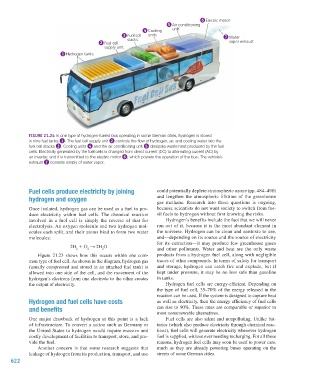Page 623 - Environment: The Science Behind the Stories
P. 623
6 Electric motor
5 Air conditioning
4 Cooling unit
3 Fuel cell units 7 Water
stacks
2 Fuel cell vapor exhaust
supply unit
1 Hydrogen tanks
Figure 21.24 In one type of hydrogen-fueled bus operating in some German cities, hydrogen is stored
in nine fuel tanks 1 . The fuel cell supply unit 2 controls the flow of hydrogen, air, and cooling water into the
fuel cell stacks 3 . Cooling units 4 and the air conditioning unit 5 dissipate waste heat produced by the fuel
cells. Electricity generated by the fuel cells is changed from direct current (DC) to alternating current (AC) by
an inverter, and it is transmitted to the electric motor 6 , which powers the operation of the bus. The vehicle’s
exhaust 7 consists simply of water vapor.
Fuel cells produce electricity by joining could potentially deplete stratospheric ozone (pp. 484–490)
hydrogen and oxygen and lengthen the atmospheric lifetime of the greenhouse
gas methane. Research into these questions is ongoing,
Once isolated, hydrogen gas can be used as a fuel to pro- because scientists do not want society to switch from fos-
duce electricity within fuel cells. The chemical reaction sil fuels to hydrogen without first knowing the risks.
involved in a fuel cell is simply the reverse of that for Hydrogen’s benefits include the fact that we will never
electrolysis. An oxygen molecule and two hydrogen mol- run out of it, because it is the most abundant element in
ecules each split, and their atoms bind to form two water the universe. Hydrogen can be clean and nontoxic to use,
molecules: and—depending on its source and the source of electricity
for its extraction—it may produce few greenhouse gases
2H 1 O S 2H O
2 2 2 and other pollutants. Water and heat are the only waste
Figure 21.23 shows how this occurs within one com- products from a hydrogen fuel cell, along with negligible
mon type of fuel cell. As shown in the diagram, hydrogen gas traces of other compounds. In terms of safety for transport
(usually compressed and stored in an attached fuel tank) is and storage, hydrogen can catch fire and explode, but if
allowed into one side of the cell, and the movement of the kept under pressure, it may be no less safe than gasoline
hydrogen’s electrons from one electrode to the other creates in tanks.
the output of electricity. Hydrogen fuel cells are energy-efficient. Depending on
the type of fuel cell, 35–70% of the energy released in the
reaction can be used. If the system is designed to capture heat
Hydrogen and fuel cells have costs as well as electricity, then the energy efficiency of fuel cells
and benefits can rise to 90%. These rates are comparable or superior to
most nonrenewable alternatives.
One major drawback of hydrogen at this point is a lack Fuel cells are also silent and nonpolluting. Unlike bat-
of infrastructure. To convert a nation such as Germany or teries (which also produce electricity through chemical reac-
the United States to hydrogen would require massive and tions), fuel cells will generate electricity whenever hydrogen
costly development of facilities to transport, store, and pro- fuel is supplied, without ever needing recharging. For all these
vide the fuel. reasons, hydrogen fuel cells may soon be used to power cars,
Another concern is that some research suggests that much as they are already powering buses operating on the
leakage of hydrogen from its production, transport, and use streets of some German cities.
622
M21_WITH7428_05_SE_C21.indd 622 12/12/14 4:29 PM

